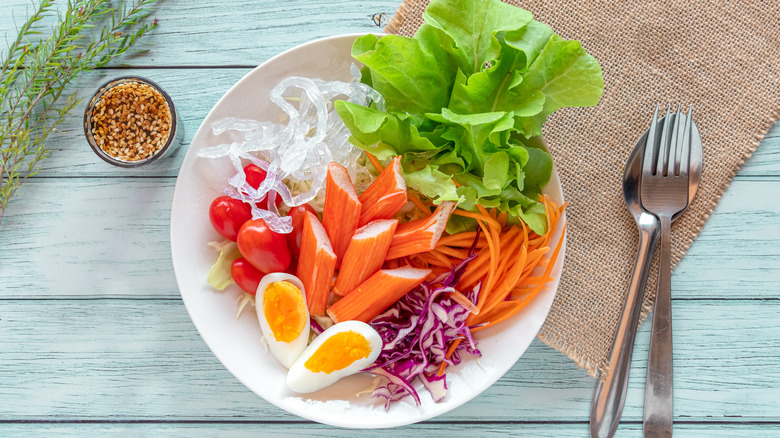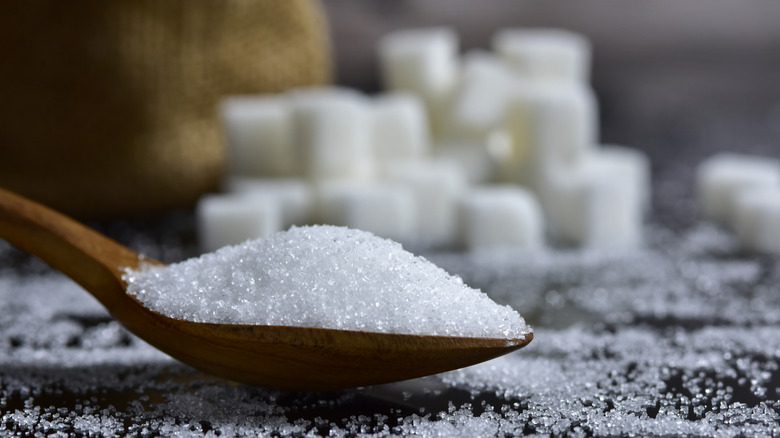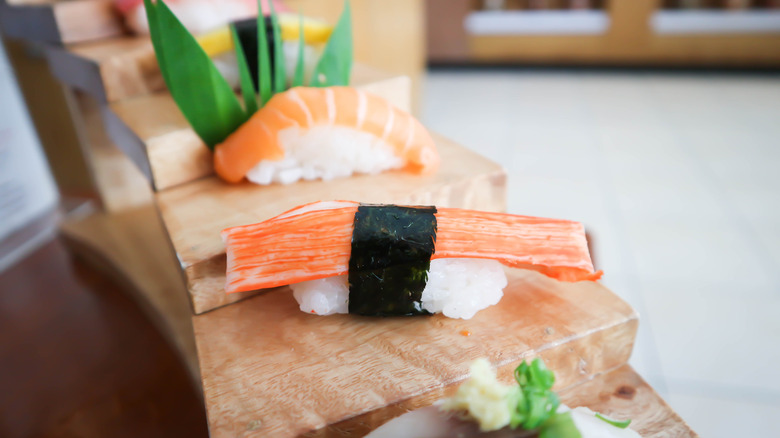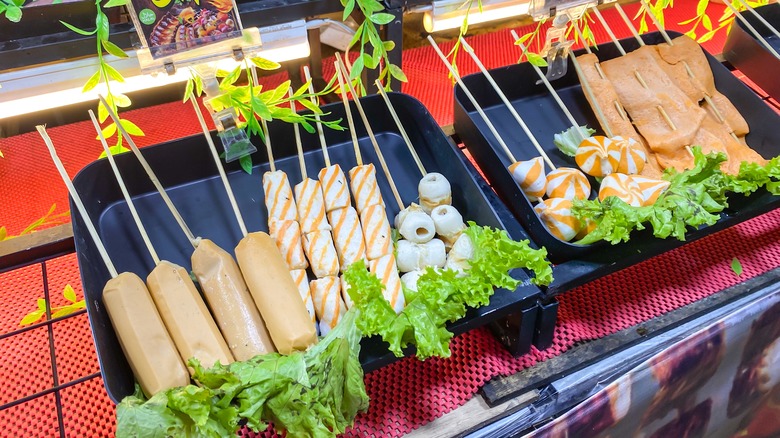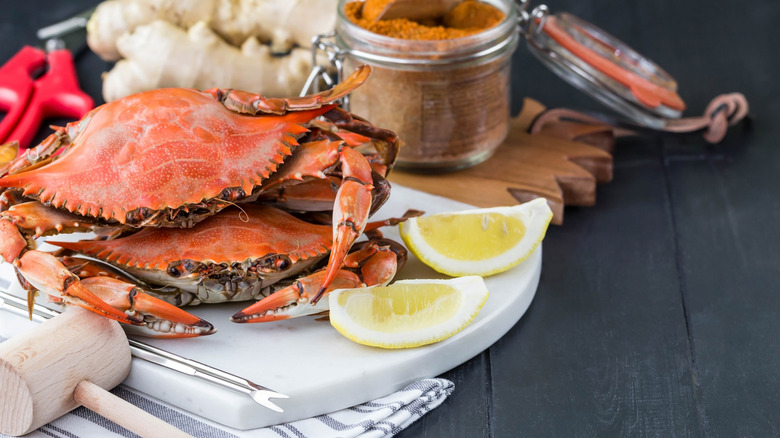What You're Really Eating When Having Imitation Crab
If you've perused the sushi options at a grocery store, you've probably come across sushi made with imitation crab. Sometimes it's labeled "krab" to distinguish it from the real meat of crustaceans. You can even buy this imitation crab meat in the seafood or frozen foods section. Real crab meat can cost about $17 for an 8-ounce tub of lump crab meat, but you can get that same amount of imitation crab meat for $2.94.
People who hail from Maryland wouldn't touch the imitation kind, but would you know the difference? Even though it's sold as imitation crab, it differs from regular crab meat in terms of its nutritional content. Emily Sullivan, a registered dietitian with MyFitnessPal, told Health Digest, "In one cup, real crab has 24 grams of protein and 0 grams of carbs whereas imitation crab has 10 grams of protein and 20 grams of carbs."
Compared to regular crab meat, imitation crab meat has half the selenium and 10% of the zinc. You'll also cut back on vitamins such as niacin, vitamin B5, folate, vitamin B12, vitamin E, and choline. Imitation crab meat might be way cheaper than authentic crab meat, but it also has some ingredients you might be surprised to know about.
Imitation crab has no crab meat
Imitation crab meat might have a similar texture and taste to non-discerning crab eaters, but most imitation crab meat doesn't have crab. "Often it is made up of shredded white fish, typically Alaska pollock, and bound together with egg whites and other ingredients," Sullivan said. "It is then heated and pressed into shapes to resemble crab legs." Some brands might have a little bit of snow crab, but it's less than 2% of the product.
The binding process required in imitation crab meat utilizes ingredients such as potato starch and cornstarch. Potato starch is a resistant starch that has the same effect on the body as fiber, according to Medical News Today. Too much potato starch could lead to feeling bloated. Cornstarch is a highly refined carbohydrate that can cause a surge in your blood sugar. Although it helps to bind the imitation crab meat, it provides little nutritional value. Eating too many processed carbs like cornstarch can lead to type 2 diabetes or coronary heart disease (per Healthline).
Imitation crab meat does have sugar
People trying to cut back on added sugar might not know that sugar is included in imitation crab meat. Imitation crab isn't meant to be sweet, but processed foods often have added sugar, salt, and fat to improve their shelf life. Eating a diet heavy in ultra-processed foods like imitation crab meat can easily increase your added sugar intake for the day. Some imitation crab meat brands get 25% of their calories from sugar.
The American Heart Association advises getting no more than 6% of your daily calories from added sugars to prevent your glucose levels from rising too rapidly. That comes to 30 grams of added sugar if you take in 2,000 calories a day. Added sugars provide empty calories that can add more pounds to the scale. Check the nutrition label of your imitation crab meat and any other ultra-processed foods you eat. You'll be surprised how quickly you can get to those 30 grams without even adding sugar to your morning coffee.
Sorbitol is found in imitation crab meat
You won't find sugar alcohols on the nutrition label, but most imitation crab meat has sorbitol. Sorbitol is derived from sugar, and it's used in the food industry to thicken and sweeten food without the calories of sugar. Sorbitol can have up to 70% of the sweetness of sugar. It's also used to keep food moist, according to a 2019 article in the International Journal of Advanced Academic Research.
Some people might notice some gastrointestinal side effects from sorbitol. Like other sugar alcohols, sorbitol isn't properly absorbed in the small intestine, so the bacteria in your large intestine ferment it, causing gas and bloating. Sorbitol also can work like a laxative because it pulls water into your large intestine. Although the U.S. Food and Drug Administration considers sorbitol safe, foods that have enough sorbitol for you to consume 50 grams must be labeled for its laxative effect. You might not overload your body with sorbitol by eating imitation crab meat, but people with celiac disease can have particular problems digesting sorbitol. Sullivan adds that imitation crab meat may also have gluten, which aggravates symptoms of celiac disease.
Imitation crab meat has many processed ingredients
Heavily processed foods often have ingredients you can't find in your kitchen or you can't pronounce. Do you have curdlan in your kitchen? Curdlan is a polymer made from sugar that forms a gel when it's heated. It prolongs the shelf life of the crab meat by preventing it from drying out. Imitation crab meat additionally has sodium tripolyphosphate to enhance its appearance. You'll also find sodium tripolyphosphate in your laundry detergent, and it's an inactive ingredient in certain medications. Although the Food and Drug Administration considers it safe, it can be toxic in high doses (per Drugs.com). Imitation crab meat has other ingredients you might not be able to pronounce, too, such as 5'-A flavor nucleotide disodium and tetrasodium pyrophosphate. You'll also find several artificial colors and flavors in imitation crab meat.
A 2024 analysis in BMJ found that eating more ultra-processed foods puts you at a higher risk for cardiovascular disease, type 2 diabetes, sleep disorders, obesity, anxiety, and other mental health disorders. They're also linked to a 21% higher risk of all-cause mortality and 66% higher risk of cardiovascular mortality.
Healthier alternatives to imitation crab meat
If you're struggling to find the key ingredient for your cream of crab soup or crab dip, Sullivan suggests going for real crab. "It has more protein and more vitamins and minerals such as zinc, B vitamins, and omega-3 fatty acids when compared to imitation crab," she said. A 100-gram serving of real blue crab meat has zero carbs, 235 milligrams of potassium, 91 milligrams of calcium, and 43 milligrams of magnesium. There's less than a gram of fat with just 0.2 grams of saturated fat.
Crabmeat found in local seafood markets might be sourced from Maryland, Virginia, or Louisiana, but commercial crab meat sold in supermarket chains might originate from Indonesia or Mexico. Although it's more expensive than imitation crabmeat, you'll basically get two ingredients: crab and sodium acid pyrophosphate (to keep the crabmeat stable). For those trying to reduce their sodium intake, real crab meat also has 395 milligrams. However, that's much less than the 770 milligrams of sodium found in some imitation crab meat.

